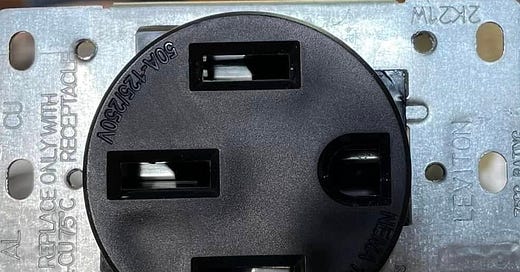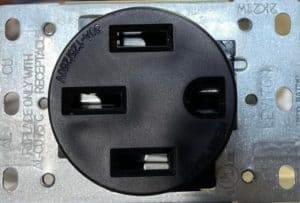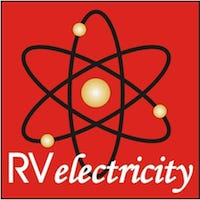Light-Duty 50-amp outlet meltdown…
Here’s my preliminary study on 50-amp outlets that aren’t rated for continuous duty
Dear Readers,
As many of you know I’ve been doing a casual study of melted shore power connectors. Some of these shore power outlet failures are caused by loose terminating screws, some by oxidation of the contacts, and some by worn-out pedestals that haven’t been properly maintained in years.
However, over on my RVelectricity group this week, someone posted a video with a very interesting theory of why this could be occurring. And no, it’s none of the above.
Not all 50-amp outlets are created equal
Here’s the full group of outlets that were tested, and it’s a real eye-opener. They range in price from $7.83 for the Leviton 50-amp outlet, to $68.88 for the Hubbell version. Now, this study was done as a way to determine why some EV home charging outlets were melting down. But the theory is the same for any RV that’s using a lot of continuous amperage from a campground receptacle.
And yes, since campgrounds will soon begin charging e-trucks and e-trailers with Level-2 chargers, this information is going to become important in the near future.
The heavy-duty, high-priced Hubbell receptacle
Take a look at the width of the contacts in this Hubbell 50-amp outlet. These are heavy-duty bronze contacts that are very thick and full width in the slot.
In the attached video you can also see that there’s an anvil clamp mechanism for terminating the conductors. This assures the lowest resistance connection possible. And as we all should know, high-resistance connections under load creates heat and meltdown.
Now, admittedly, at $68.88 each the Hubbell connector is the most expensive 50-amp shore power outlet you can buy, but it’s also the most ruggedly built. And that’s exactly why all Hubbell products are great examples of how to build a heavy-duty 14-50 receptacle.
What about the inexpensive Leviton outlet?
Here’s the cheapest 50-amp outlet you can buy, this one from Leviton. They list this as a light-duty receptacle, and you can see that the contacts appear to be steel (which is subject to corrosion) and half the width of the slot. So this will not make full contact with the male prongs that plug into it.
Both of these design elements contribute to high-resistance connections that can overheat and cause a meltdown. Plus, there’s a simple terminating screw in the back without a clamp anvil that doesn’t guarantee the best possible wiring connection.
While this design might be okay for a residential stovetop that doesn’t pull a full 50 amps of current for hours on end, I’m not sure I would trust this in a campground pedestal for an RV. And I certainly wouldn’t trust it to charge an EV for 10 hours of continuous current draw.
Watch the HandyDadTV video for more info
I think this is a very well put together video from HandyDadTV with a lot of great information. And while the video maker didn’t actually do a high-current meltdown test with a FLIR infrared camera like I could do in my lab, his theory of failure is sound, and he’s sticking to the science. To watch his video click on the picture or HERE.
That’s why I’m now looking for a grant that would allow me to do a weeks-long over-current test of 30- and 50-amp receptacles, using multiple test samples from all the major manufacturers. The plan would be to find the best performing 30- and 50-amp outlets for campground pedestals and home EV charging outlets.
And I would love to compare notes with HandyDad once I have more intel. I’ll keep you posted.
Let’s play safe out there…. Mike










Great discussion! I’d love to see an infrared camera study showing time lapse thermal images during an EV charging cycle. Hubble vs the ones with the highest Amazon ratings?
Great info, the pics alone of Hubble vs Leviton speak volumes.
Would be great to add to your potential upcoming test other common RV 50A connection types like the Smartplug and ring-locking Hubbell connector, esp as used as shore power inputs to a coach, or generator outputs, where you presumably wouldn’t want a male 14-50 plug.